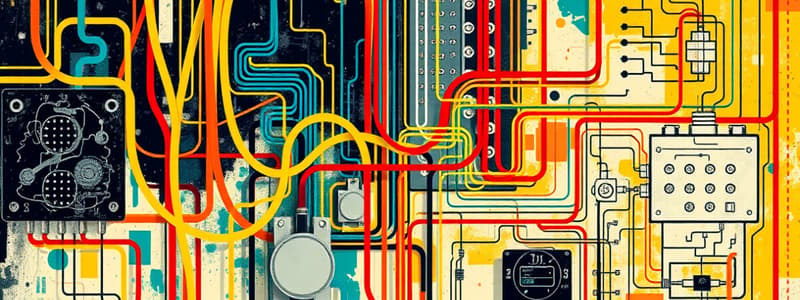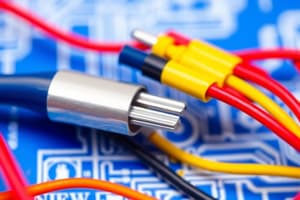Podcast
Questions and Answers
What is the primary purpose of a schematic diagram in a wiring context?
What is the primary purpose of a schematic diagram in a wiring context?
- It provides real-life examples of circuit operation.
- It shows wire colors and their connections.
- It depicts the physical layout of components within a panel.
- It simplifies identification of loads, switches, and circuits. (correct)
Which components can typically be found wired in parallel within refrigeration systems?
Which components can typically be found wired in parallel within refrigeration systems?
- Thermostats and timers.
- Circuit breakers and transformers.
- Compressors and fan motors. (correct)
- Thermostats and capacitors.
What is depicted in a pictorial diagram?
What is depicted in a pictorial diagram?
- The schematics of circuit layouts using symbols.
- The operational conditions based on temperature settings.
- The legend explaining symbols and abbreviations.
- The actual wiring layout and component locations. (correct)
In gas furnace operation, what is the role of the thermocouple?
In gas furnace operation, what is the role of the thermocouple?
What voltage is indicated by circuit connections between power supply terminals L1 and L2?
What voltage is indicated by circuit connections between power supply terminals L1 and L2?
How does a dehumidifier primarily manage humidity levels?
How does a dehumidifier primarily manage humidity levels?
What function does a low-voltage circuit serve in packaged air conditioning equipment?
What function does a low-voltage circuit serve in packaged air conditioning equipment?
Which two components are utilized in the low-voltage control circuit of a gas furnace?
Which two components are utilized in the low-voltage control circuit of a gas furnace?
Flashcards are hidden until you start studying
Study Notes
Understanding Wiring Diagrams
- Wiring diagrams are essential for interpreting equipment operation, installation, troubleshooting, and repairs in refrigeration and HVAC systems.
- Different types of wiring diagrams include schematic, pictorial, and combinations of both.
Schematic Diagrams
- The schematic diagram is the most useful and straightforward for understanding system operations.
- It uses symbols and lines to represent loads, switches, and circuits, facilitating easy identification.
- Power is supplied to terminals L1 and L2, with the controlled device typically being a compressor managed by a thermostat that closes on temperature increases.
- The legend in the diagram explains abbreviations and symbols used, aiding in clarity.
Pictorial Diagrams
- Pictorial diagrams depict the actual wiring layout and component locations within a control panel.
- Each wire and its color are shown, simplifying the identification of circuit components located outside the control panel.
Power Supply and Circuit Identification
- Circuit connections between power supply terminals L1 and L2 usually indicate a 230 volts supply.
- Circuits can include components like fan motors and thermostats, wired in parallel or series depending on operation needs.
- Multiple loads (e.g., compressor and blower motor) can be operated in parallel, each controlled by separate switches.
Real-Life Examples
- A dehumidifier operates with a compressor, fan motor, and humidistat wired appropriately to manage humidity levels.
- Window air conditioners feature similar components, with control switches enabling fan-only or cool settings. The fan continues running even when the compressor cycles off.
- Walk-in coolers and freezers incorporate multiple components: compressors, fan motors, and timers, with different operational conditions based on temperature settings.
Gas Furnace Operation
- Stand-alone gas furnaces commonly use a thermostat and thermocouple, with low-voltage control circuits managing the fan motor and gas valve operations.
- Three thermostats are present: one for heating, a safety limit switch, and a fan switch, ensuring safety and proper function during heating cycles.
Packaged Air Conditioning Equipment
- Packaged units include all components except the thermostat, connected via a low-voltage circuit.
- Transformers are used to provide low voltage to control the thermostat, which manages the compressor and fan operations.
Conclusion and Wiring Diagram Familiarity
- Understanding wiring diagrams, especially schematics and pictorials, is crucial for technicians to troubleshoot effectively.
- Knowledge of how loads and control circuits operate—parallel loads function independently, while series switches control operations—is vital for system comprehension.
- Transformers are integral in supplying low voltage to control the operation of higher voltage components.
Understanding Wiring Diagrams
- Wiring diagrams are crucial for understanding operation, installation, troubleshooting, and repairs in refrigeration and HVAC systems.
- Types of wiring diagrams include schematic, pictorial, and hybrid forms combining both styles.
Schematic Diagrams
- The schematic diagram simplifies system operations using standardized symbols and lines to represent electrical components.
- Power is supplied to terminals L1 and L2; the compressor typically acts as the controlled device, governed by a thermostat that activates on temperature increases.
- A legend within the diagram provides explanations for symbols and abbreviations, enhancing comprehension.
Pictorial Diagrams
- Pictorial diagrams visually represent the wiring setup and component placement in a control panel.
- They display the actual wires and colors, making it easier to identify components located outside the control panel.
Power Supply and Circuit Identification
- Circuit connections between power terminals L1 and L2 generally indicate a supply voltage of 230 volts.
- Components such as fan motors and thermostats can be wired in parallel or series based on functional requirements.
- Parallel wiring allows multiple loads like compressors and blower motors to operate independently, each controlled by separate switches.
Real-Life Examples
- Dehumidifiers utilize compressors, fan motors, and humidistats all wired to control humidity effectively.
- Window air conditioners have similar components, with control switches to toggle between fan-only and cooling modes, allowing the fan to continue running when the compressor cycles off.
- Walk-in coolers and freezers feature multiple components, including compressors, fan motors, and timers, adapting operations based on preset temperature conditions.
Gas Furnace Operation
- Stand-alone gas furnaces typically integrate a thermostat and thermocouple, utilizing low-voltage control circuits for fan motor and gas valve management.
- Furnaces contain three critical thermostats: one for heating, a safety limit switch, and a fan switch, ensuring safe and efficient heating cycles.
Packaged Air Conditioning Equipment
- Packaged units incorporate all necessary components except for the thermostat, interlinked via a low-voltage circuit.
- Transformers provide low voltage to control the thermostat, which in turn manages operations of the compressor and fan.
Conclusion and Wiring Diagram Familiarity
- Proficiency in interpreting wiring diagrams, especially schematic and pictorial forms, is vital for technicians undertaking troubleshooting tasks.
- Understanding operation principles of loads and control circuits—where parallel loads operate independently while series switches manage operations—is essential for system mastery.
- Transformers play a key role in supplying low voltage to control higher voltage components, ensuring proper functionality within the system.
Studying That Suits You
Use AI to generate personalized quizzes and flashcards to suit your learning preferences.




